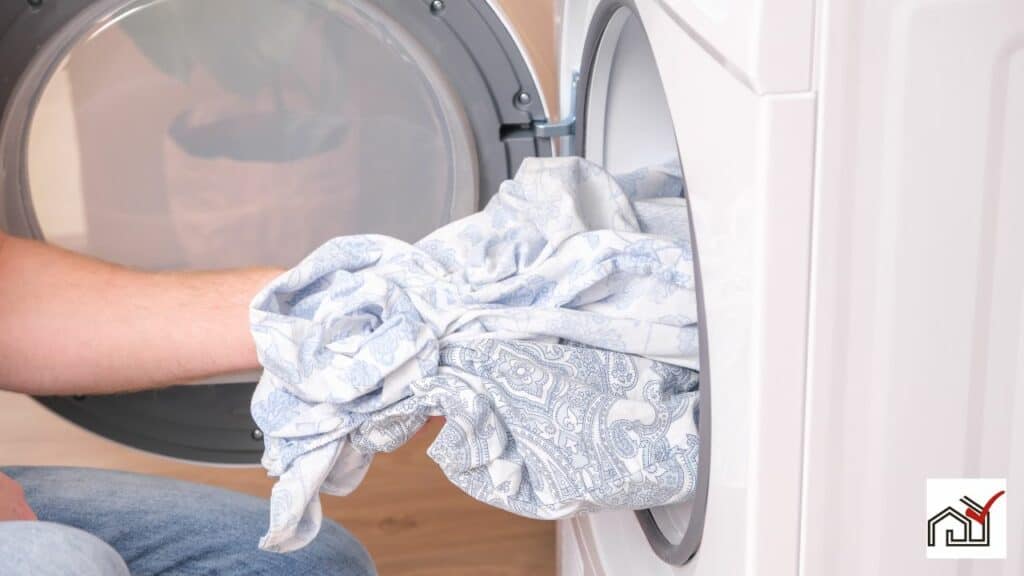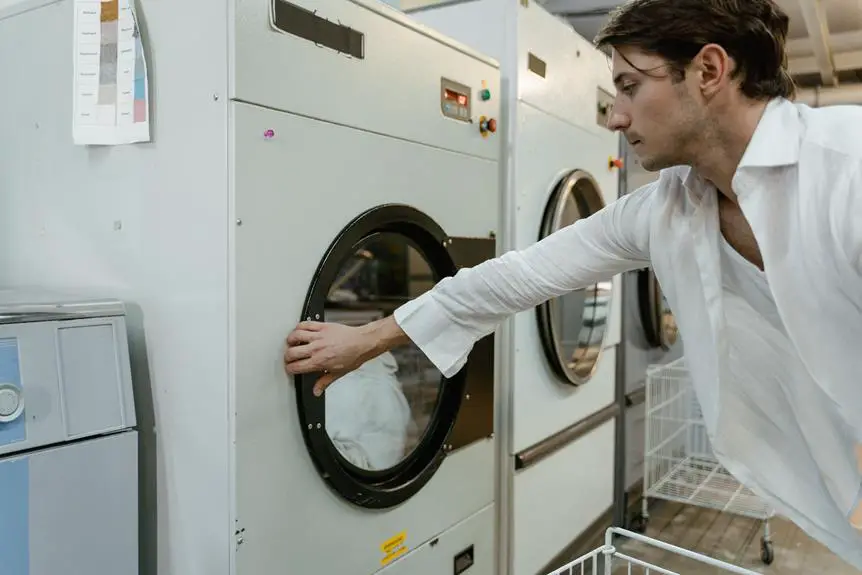If your Kenmore Elite dryer isn't heating up, several issues could be the cause. Common problems include a tripped circuit breaker, a faulty heating element, or a problem with the power supply.
Other potential issues could be a defective thermostat, faulty gas valve solenoids, a clogged lint screen, or blocked vents which can prevent proper airflow. A blown thermal fuse is another typical issue to check for.
Motor and drive system should also be examined during troubleshooting.
If these initial checks don't fix the problem, you might need to seek professional help.
Checking Power Supply
Before diagnosing the heating issue of your Kenmore Elite dryer, confirm it receives the needed 220-volt power supply. Kenmore Elite Electric Dryers require more voltage than standard appliances.
An initial step if the dryer does not heat is to verify the outlet's voltage with a multimeter set to measure voltage. Check for 120 volts between each side post and the center post, and 220 volts between the two side posts of the outlet.
If the outlet voltage is correct, inspect the dryer's electrical connectors at the back for secure connections and absence of damage or corrosion. Also, review the dryer's control board, which directs electricity to components, including the heating element. A faulty control board could cause heating issues, even with proper power supply.
Tripped Circuit Breakers
If your Kenmore Elite dryer isn't heating, first check the circuit breakers to see if they have tripped, which would stop power from reaching the heating element. Electric dryers need a lot of power, and a tripped breaker will make the dryer run without producing heat.
Circuit breakers can trip due to power surges or electrical system overloads. Locate the electrical panel in your home and find the dryer's breaker. If it's off or in the middle, flip it back to 'On' to re-establish power. If it trips again quickly, this could signal a serious electrical issue, and you may need to contact a professional.
The dryer also has safety features like a thermal fuse and thermal cutoffs to prevent overheating by cutting power. If the circuit breaker isn't the issue, check these parts. If they're blown or triggered, the heating element won't work. Test these parts for continuity and replace them if needed.
Ensure the control panel and electronics are working properly. If there's a problem with these, you might need to get the dryer repaired by a professional.
Regularly cleaning your dryer and its ducts can help prevent issues and make the dryer last longer.
Thermostat Issues
A malfunctioning thermostat can cause a Kenmore Elite dryer not to heat, as it controls the appliance's temperature and affects the heating element's power supply. To troubleshoot, one should consider the thermostat's relationship with the thermal fuse and thermal cut-off. The thermal fuse is a safety feature that, if blown, must be replaced for the dryer to heat again. If the fuse is intact, the thermostat may be at fault.
To test the thermostat, use a multimeter to check for continuity at room temperature. A lack of continuity implies a faulty thermostat that needs replacing. Similarly, test the thermal cut-off located on the heating element housing; it should also show continuity, and if not, it needs replacing.
Additionally, inspect the heating circuit's resistance values for any irregularities that could impact the thermostat.
Turn off and unplug the dryer before any repairs, and follow safety guidelines. If unsure about handling electrical components, seek assistance from a professional technician for the thermostat issues.
Heating Element Failure
A Kenmore Elite dryer not heating often indicates a failed heating element. This component generates heat, and if it breaks or burns out, the dryer will spin without warming, leaving clothes damp. A lack of heat despite the dryer running suggests the element might be the issue. A continuity test with a multimeter can check for an open circuit; no continuity means the element requires replacement.
Before replacing the heating element, examine the thermal fuse, which shuts off power to the element if the dryer overheats. A blown thermal fuse can cause the same symptoms as a failed heating element. Replacing the fuse may resolve the issue, but it's also necessary to identify and address the underlying cause to prevent recurrence.
It's important to thoroughly inspect and troubleshoot the heating element and associated parts in a non-heating Kenmore Elite dryer to ensure longevity and efficiency.
Gas Valve Solenoid Problems
Defective gas valve solenoid coils in Kenmore Elite dryers can lead to inadequate heating, as they may fail to open the gas valve despite the igniter being active. This problem prevents the dryer from heating properly, leaving clothes damp after a cycle. Some users have temporarily fixed this by replacing the solenoid coils; however, this is not always a lasting solution, suggesting a more complex issue within the gas valve system. Technicians often need to investigate further to find the root cause when heating problems persist after coil replacement.
It is also essential to check the thermal fuse, a safety device that stops the dryer from overheating. If the thermal fuse is blown, it will stop the heating process. Therefore, it should be checked to ensure it is not the cause of the heating problem before replacing the solenoid coils.
If the thermal fuse is functional and replacing the solenoid coils does not fix the heating issue, it may be necessary to replace more advanced components like the control access panel or the power control module, which are crucial for the dryer's operation.
Clogged Lint Screen and Vents
Maintaining proper airflow in a dryer is essential for its operation. A common issue that can disrupt this is a clogged lint screen and vents. This blockage can reduce heating efficiency in dryers, including the Kenmore Elite model. A clear path for air to circulate is necessary for drying clothes and managing the dryer's temperature. A lint-filled screen limits air movement, causing the heating element to work harder and potentially overheat.
To maintain your Elite dryer, clean the lint screen after each use. Remove it and brush off the lint. If the screen is coated with residue that doesn't brush off, wash it with warm, soapy water and ensure it's completely dry before replacing it.
The dryer's vents can also become clogged, trapping heat inside the machine, reducing drying capacity, and creating a fire hazard. Check the external vent flap for blockages like nests or lint accumulation. If the dryer heats up but then stops, the vents may be blocked and require cleaning, sometimes by a professional.
Keeping the Kenmore Elite Dryer's lint screen and vents clean is key to preventing heating problems and extending the life of the heating element.
Faulty Thermal Fuse
A blown thermal fuse often causes a Kenmore Elite dryer to stop heating. The thermal fuse is a protective component that interrupts power to the heating element if the dryer overheats. If the dryer isn't heating properly, checking the thermal fuse is essential.
To check the thermal fuse, one needs to open the dryer and locate the fuse, which is usually on the blower housing or near the heating element. A continuity test with a multimeter can confirm if the fuse is blown; no continuity means the fuse must be replaced.
If the dryer still doesn't heat after replacing the thermal fuse, other parts like the heating element or control panel may be at fault. Persistent heating issues, even after changing the thermal fuse, heating coil, and humidity sensor, suggest a more complex electrical issue or a faulty control panel that may require professional repair.
Motor and Drive System Checks
A malfunctioning motor or drive system can cause heating issues in a Kenmore Elite dryer. The motor operates the drum and a centrifugal switch, which is necessary for the heating element to work. If the motor doesn't start or the switch is defective, the dryer may not heat.
To check the motor and switch, listen for unusual noises when starting the dryer. A malfunctioning motor might make a humming noise or fail to start. If the motor works but there's no heat, the switch could be faulty. Test the switch with a multimeter for continuity; no continuity means it needs replacing.
Also, inspect the moisture sensor wiring, as damaged wiring can affect the sensor and control board communication, leading to heating issues. Make sure the wiring is intact and secure.
If the dryer has a timed dry option, use it to check if the problem is with the sensors or the motor system. If the dryer heats on timed dry, the issue may be with the moisture sensor or wiring. If there's no heat, further investigate the motor and drive system to ensure all parts are working correctly.





